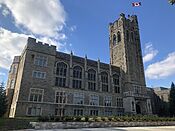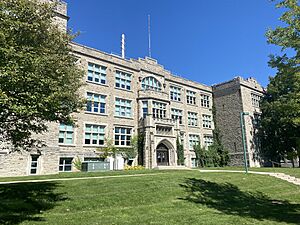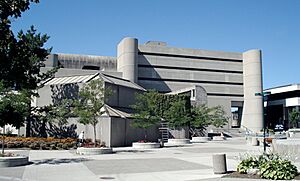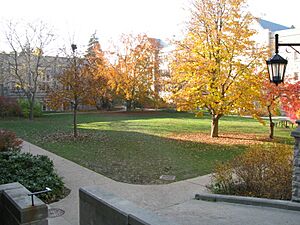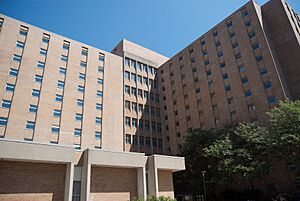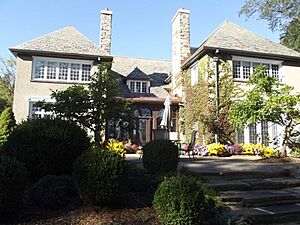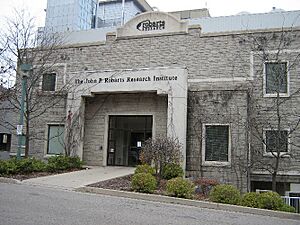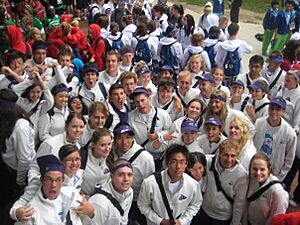University of Western Ontario facts for kids
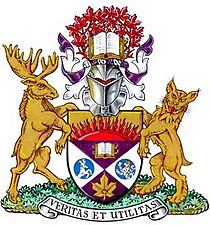
|
|||
|
Other name
|
Western University | ||
|---|---|---|---|
|
Former names
|
The Western University of London, Ontario | ||
| Motto | Veritas et Utilitas (Latin) | ||
|
Motto in English
|
Truth and usefulness | ||
| Type | Public | ||
| Established | 7 March 1878 | ||
|
Academic affiliations
|
ACU, CARL, COU, CUSID, Fields Institute, Universities Canada, U15 | ||
| Endowment | CA$1.3 billion (2024) | ||
| Budget | CA$930 million | ||
| Visitor | Edith Dumont (ex officio as Lieutenant Governor of Ontario) | ||
| Chancellor | Kelly Meighen | ||
| President | Alan Shepard | ||
| Provost | Florentine Strzelczyk | ||
|
Academic staff
|
1,432 | ||
| Students | 36,205 | ||
| Undergraduates | 29,358 | ||
| Postgraduates | 6,847 | ||
| Location |
43°00′30″N 81°16′21″W / 43.00833°N 81.27250°W |
||
| Campus | Urban, 455 hectares (1,120 acres) | ||
| Colours | Western Purple and White
|
||
| Nickname | Mustangs | ||
|
Sporting affiliations
|
U Sports, OUA | ||
| Mascot | JW the Mustang | ||
 |
|||
Western University, also known as The University of Western Ontario (UWO), is a large public university in London, Ontario, Canada. It's a place where students go to learn and do important research. The main campus is huge, covering about 455 hectares (1,124 acres). It's surrounded by homes and has the Thames River flowing through part of it. Western University has twelve different schools and faculties where students can study many subjects.
The university started on March 7, 1878. It was first called "The Western University of London, Ontario." It grew from an older school called Huron College, which began in 1863. At first, it had four main areas of study: Arts, Divinity, Law, and Medicine. In 1908, it became a university for everyone, not just one religious group. After World War II, the university grew a lot, adding many new faculties and schools.
Western is a university for both male and female students. It has over 24,000 students and more than 306,000 former students living all over the world. It's also a founding member of the U15, which is a group of Canada's top universities known for their research. Western's sports teams are called the Western Mustangs. They compete in the Ontario University Athletics conference, which is part of U Sports.
Contents
Discovering Western University's Past
The university was founded on March 7, 1878, by Bishop Isaac Hellmuth. It was first known as The Western University of London, Ontario. The first leader of the university was Chief Justice Richard Martin Meredith. It included Huron College, which had started in 1863. The first four areas of study were Arts, Divinity, Law, and Medicine. When classes began in 1881, there were only 15 students.
Even though the university started in 1878, it wasn't until June 20, 1881, that it could give out degrees in arts, divinity, and medicine. In 1882, the university's name changed slightly to The Western University and College of London, Ontario. The first graduation ceremony happened on April 27, 1883. At first, the university was connected to the Church of England, but in 1908, it became open to people of all beliefs.
In 1916, the university bought the land where its main campus is today. There are two special plaques in University College that remember students and graduates who died in World War I. A third plaque honors those who served with the No. 10 Canadian General Hospital during World War II. This unit was created and supported by Western.
In 1923, the university was officially renamed The University of Western Ontario. The first two buildings on the new campus were the Arts Building (now University College) and the Natural Science Building (now the Physics and Astronomy Building). Classes started at the current location in 1924. The tall tower of University College, a famous part of the university, is called the Middlesex Memorial Tower. It honors the brave men from Middlesex County who fought in World War I.
Over the years, some other schools became connected to Western. For example, Brescia College joined in 1919, and Assumption College also became affiliated. Other schools like Waterloo College of Arts and King's College also joined later. Brescia College joined Western's main campus in 2024, while Huron and King's are still independent but connected.
Two more plaques honoring World War II service are on the Physics and Astronomy Building. They list students and graduates who served, including those from the No. 10 Canadian General Hospital.
Even though the number of students was small for many years, the university started to grow a lot after World War II. It added many new faculties, like the Faculty of Graduate Studies in 1947 and the School of Business Administration (now the Ivey Business School) in 1949. Other additions included Engineering in 1957, Law in 1959, Education in 1965, and Music in 1968.
In 2012, the university started using the name "Western University" more often. This was to make the school seem more international. The president at the time, Dr. Amit Chakma, said they wanted to be known worldwide. However, the official legal name is still "The University of Western Ontario," and this name is used on official documents like transcripts and diplomas.
Exploring Western University's Campus
Western University is located in London, Ontario, a city in southwestern Canada. Most of the campus is surrounded by homes, and the Thames River flows through the eastern part. Western Road is a main street that runs through the university from north to south. The central campus, where most student homes and classrooms are, is about 170.8 hectares (422 acres).
The current campus started to be built in the 1920s. Many of the first buildings were designed in a style called Collegiate Gothic, which looks like old European castles. As the campus grew in the late 1960s, the university started building in more modern styles. In 2000, new plans for the campus focused on making the center only for academic buildings. The newest academic building is the Amit Chakma Engineering Building, which opened in September 2018. The Western Interdisciplinary Research Building (WIRB) is even newer. It has advanced research facilities for studying the human brain.
Libraries and Art Galleries at Western
The university has a library system called Western Libraries. It has six libraries with over 2.45 million books, plus many online resources like e-books and databases. Some of the libraries include the Allyn and Betty Taylor Library, the C. B. Johnston Library, and the D. B. Weldon Library. The D. B. Weldon Library also keeps the university's historical records and special collections. Western Libraries also shares its catalog with the libraries of its affiliated colleges, like Huron and King's.
Western also has two art galleries: the Artlab Gallery and the McIntosh Gallery. The Artlab Gallery shows about 14 projects each year, focusing on new and experimental art. The McIntosh Gallery is a public art gallery that opened in 1942. It's the oldest university art gallery in Ontario. It shows art history and modern visual art.
Western also works closely with the Museum of Ontario Archaeology. This museum started from a collection of old artifacts kept in different buildings, including Western's University College. It officially opened in 1978.
Student Homes and Fun Places
The main campus of Western University has nine student residences, which are like dorms. These homes are for both first-year students and older students. In September 2015, about 23% of undergraduate students lived on campus, including almost 79% of all first-year students. Each residence has its own student council.
Some residences are traditional, with shared rooms, like Delaware Hall and Saugeen-Maitland Hall. Others are suite-style, with more private spaces, like Alumni House and Elgin Hall. Some are a mix of both. Alumni House and London Hall are only for older students. The biggest residence is Saugeen–Maitland Hall, which can house 1,252 first-year students.
The University Community Centre (UCC) is like a student hub. It's where student government offices are, and where many social, cultural, and fun activities happen. The University Students' Council has its offices here. The Society of Graduate Students, for graduate students, is in the Middlesex College building.
Other University Locations
Besides the main campus, Western University owns other properties in Southwestern Ontario. These include several research facilities called Western Research Parks. These parks help connect university research with businesses.
Discovery Park is the oldest research park, started in 1989. It has government labs and research centers. It also has a hotel and conference center called Windermere Manor. The Advanced Manufacturing Park is another research park, where the WindEEE Dome is located. The WindEEE Dome is the world's first hexagonal wind tunnel. It helps scientists study how wind affects buildings and bridges, and can even simulate tornados. In 2003, Western opened the Sarnia-Lambton Research Park, which is Canada's largest clean technology business incubator.
The university also manages some homes outside the main campus. Gibbons Lodge is the official home for the university president. It was built in 1932 and bought by the university in 1960. There's also Platt's Lane Estates, which has townhouses and apartments for older students, graduate students, and students with families.
Western's Commitment to a Green Campus
Western University cares about being environmentally friendly. A special committee helps make sure the university is sustainable. They work to include sustainability in classes, support research on environmental issues, use eco-friendly landscaping, and build new facilities that save energy. Western has signed pledges to be a model of environmental responsibility and is part of the Talloires Declaration, which is about sustainability for universities.
How Western University is Managed
Western University is managed by two main groups: the Board of Governors and the Senate. The Senate was the first governing body, created when the university started in 1878. The Board of Governors was created later, in 1892. The Board is in charge of the university's money and overall management. It includes the university's chancellor, president, the mayor of London, and other members chosen from the university and local community, including students.
The Senate is responsible for all academic rules and policies. It includes the chancellor, president, deans of each faculty, the university librarian, and elected members from the faculty, students, and affiliated colleges.
The president and vice-chancellor is the main leader of the university. They oversee all the academic and administrative work. Alan Shepard became the tenth president on July 1, 2019. The chancellor is an honorary leader of the university. The current chancellor is Kelly Meighen, who started her four-year term on July 1, 2023.
Schools Connected to Western
Western University is currently connected with two university colleges: Huron University College and King's University College.
Huron University College started in 1863 and became Huron University College in 2000. It has been connected to Western since Western's first official charter in 1878. King's University College started in 1954 as a Catholic liberal arts college. It changed its name to King's College in 1966 and King's University College in 2004. Even though these colleges have religious connections, students of any religious belief can attend them.
Western also has a connection with St. Peter's Seminary through King's University College. St. Peter's Seminary opened in 1912 as a seminary for the Roman Catholic Diocese of London.
From 1919 until 2024, Western was also connected with Brescia University College. Brescia was an all-women's Catholic university college. It started to join Western's main campus in September 2023 and officially stopped operating as a separate college in May 2024.
Learning and Research at Western
Western is a public research university. Most of its students are full-time undergraduate students. The university also has many graduate students. In 2008–2009, the university awarded thousands of bachelor's, master's, and doctoral degrees. Students can get financial help like loans and grants from the government to pay for their studies.
The university has 11 main faculties and schools. These include the Don Wright Faculty of Music, Faculty of Arts & Humanities, Faculty of Education, Faculty of Engineering, Faculty of Health Sciences, Faculty of Information & Media Studies, Faculty of Law, Faculty of Science, Faculty of Social Science, Ivey School of Business, and the Schulich School of Medicine & Dentistry. In September 2016, most undergraduate students were in the Faculty of Social Sciences. The School of Graduate and Postdoctoral Studies manages graduate education.
To get into Western, students need to meet certain requirements, which can vary depending on where they went to high school. In September 2012, the average high school grade for first-year students was 89.3 percent. For the fall of 2013, about 45,000 students applied for only 4,900 spots.
Western also offers students chances to study in other countries through exchange programs, internships, and international trips.
Western University's Global Standing
| University rankings | |
|---|---|
| Global rankings | |
| ARWU World | 201–300 |
| QS World | =120 |
| Times World | 201–250 |
| U.S News & World Report Global | 311 |
| Canadian rankings | |
| ARWU National | 9–12 |
| QS National | 6 |
| Times National | 9–10 |
| U.S News & World Report National | 10 |
| Maclean's Medical/Doctoral | 11 |
| Maclean's Reputation | 9 |
Western University is recognized as one of the top universities in the world. In 2022, it ranked among the top 201–300 universities globally and 9–12 in Canada by the Academic Ranking of World Universities. The 2024 QS World University Rankings placed Western 114th in the world and sixth in Canada. The 2023 Times Higher Education World University Rankings ranked Western 201–250 globally and 8–10 in Canada. U.S. News & World Report ranked Western 300th in the world and tenth in Canada in its 2022–23 global university rankings.
The university also ranks well for how easily its graduates find jobs. In QS's 2022 ranking for graduate employability, Western was 43rd in the world and third in Canada. Overall, Western is considered among the top 1% of higher education institutions worldwide.
Important Research at Western
Western focuses on four main areas of research: life sciences and human health, culture and values, the environment, and social and economic trends. In 2018, Western was ranked 10th among Canadian research universities. In 2017, the university received over $249 million for research from outside sources. The Canadian government provides almost half of Western's research funding.
Western's research is also recognized in global rankings that look at how often its academic papers are cited. In 2019, the Performance Ranking of Scientific Papers for World Universities ranked Western 197th in the world and ninth in Canada.
Research on the human brain is a big focus at Western. The Brain and Mind Institute studies cognitive neuroscience. In 2011, researchers there found that blind people might use the visual part of their brain for echolocation. Another study suggested that people who are deaf from birth might use the part of their brain normally used for hearing to improve their sight. Western also has the Institute for Earth and Space Exploration, which is the first dedicated space institute in Canada to offer a planetary science degree.
In 2014, the university announced plans for a new facility to research diseases like HIV. The Schulich School of Medicine & Dentistry's Department of Microbiology and Immunology is well-known globally. This is partly thanks to Dr. Chil-Yong Kang, a Western researcher who has been testing a preventive HIV/AIDS vaccine called SAV001-H. This vaccine is based on a modified, inactive HIV-1 virus. Early tests showed it was safe and helped create antibodies. It is the only HIV vaccine being developed in Canada and one of only a few in the world.
Student Life at Western University
| Undergraduate | Graduate | |
|---|---|---|
| Male | 43.9% | 45.0% |
| Female | 56.1% | 55.0% |
| Canadian student | 90.1% | 78.0% |
| International student | 9.9% | 22.0% |
The two main student groups that represent students are the University Students' Council (USC) for undergraduate students and the Society of Graduate Students for graduate students.
The University Students' Council (USC) is a group run by students that helps and supports undergraduate students. It started in 1930 and officially became the "University Students' Council" in 1947.
Today, the USC is a non-profit organization that represents about 38,000 undergraduate students. It works to support students and speaks for them to the university and government. The USC recognizes over 220 student groups and clubs, with more than 15,000 students involved. These clubs cover many interests like academics, culture, religion, and sports. The USC also runs places like two pub/restaurants (The Spoke and The Wave) and a clothing store (The Purple Store). There's also a student-run food bank and a Peer Support Centre to help students with their well-being.
The USC also supports two student media groups: The Gazette, a student newspaper that has been published since 1906, and RadioWestern, an FM radio station.
There are also many fraternities and sororities at Western.
Sports and Recreation at Western
Sports at Western are managed by Sports & Recreation Services. The university's sports teams are called the Western Mustangs. They compete in the Ontario University Athletics conference. Western does not give full sports scholarships.
The university has many sports facilities for its teams and students. The Western Student Recreation Centre, opened in 2009, has a large pool and several gyms. It's often called the WSRC or the Rec Centre.

Western Alumni Stadium (formerly TD Stadium) is the university's main stadium. It opened in 2000 and can hold over 8,000 people. It's home to the university's football team and has hosted big events. The Thompson Recreation & Athletic Centre has an ice rink, tennis courts, and a track. It's home to the ice hockey and track and field teams. Alumni Hall is another sports venue for basketball, volleyball, and other indoor events.
Many Western students play in intramural sports leagues and tournaments. These are offered at different skill levels for various sports, including traditional ones like volleyball and soccer, and unique ones like dodgeball. Western also hosts high school football games at its stadium. The university has several school songs, including "Western", which is often played at football games by the Western Mustang Band.
Performances and Arts
The Don Wright Faculty of Music offers almost 400 performances, masterclasses, and recitals each year. Most of these are open to the public. The Western University Symphony Orchestra and Chamber Orchestra perform regularly. The UWOpera group performs many different types of opera in the Paul Davenport Theatre. There are also other student-run drama groups that put on shows every year.
Student Media Outlets

Western's students run several media outlets on campus. The University Students' Council owns and operates the campus radio station CHRW-FM (94.9 FM). The first campus radio at Western started in 1971, and the current station, RadioWestern, began in 1979.
The University Students' Council used to run a TV station called tvWestern.ca, which started broadcasting in 1994 but was stopped in 2010.
The Student Newspaper
The Gazette, also known as the Western Gazette, is the university's student newspaper. It has been published since 1906. It started as a handwritten newspaper in 1902 and became The Gazette in 1908. The Gazette stopped publishing during World War I but started again in 1919. In 1930, it changed its name to the University of Western Ontario Gazette.
The Gazette used to be printed four days a week from 1991 to 2015, making it the only student newspaper in Canada to be considered a daily. In 2017, it started printing once a week, and in 2020, it moved fully online due to the Covid pandemic. In 2021, the Gazette began to return to print, focusing on special editions and bi-weekly issues in the fall of 2022.
The paper is owned by the University Students' Council (USC), but its editorial decisions are independent. Many former Gazette staff have gone on to work at major media companies like The Globe and Mail, Toronto Star, National Post, CBC, and The New York Times.
Student Support Programs
Leadership Education
The Leadership Education Program helps students learn how to be good leaders, both on their own and in teams.
Student Exchange Programs
Western University offers a student exchange program that allows students to study abroad at over 85 different universities in 25 countries. Each year, almost 400 students come to Western as exchange students from other countries.
Famous People from Western University
-
John Robarts, former Premier of Ontario
-
Sir Frederick Banting, Nobel Prize winner for insulin
-
Margaret Chan, former Director General of the World Health Organization
-
Kevin O'Leary, television personality
-
Roberta Bondar, first Canadian female astronaut
-
Jagmeet Singh, leader of the New Democratic Party
-
Simu Liu, Canadian actor
As of November 2007, Western University had over 220,000 former students living in more than 100 countries. Throughout Western's history, its faculty, alumni, and former students have achieved great things in many fields. They have won awards like the Nobel Prize and the Pulitzer Prize. For example, former faculty member Frederick Banting won the Nobel Prize in Physiology or Medicine for discovering insulin. Alice Munro, who won the Nobel Prize in Literature in 2013, studied English at Western. Two Western graduates, Bjarni Tryggvason and Roberta Bondar, have even traveled to space.
Many former students have become important leaders in government, like James Bartleman, who was the Lieutenant Governor of Ontario, and Sheila Copps, who was Deputy Prime Minister of Canada. Western's alumni also include several provincial premiers, such as John Robarts and David Peterson from Ontario, and Don Getty from Alberta. Some graduates have also held important international positions, like Margaret Chan, who was the Director-General of the World Health Organization.
A large number of successful business and economics leaders have also studied at Western. These include Stephen Poloz, former Governor of the Bank of Canada; Kevin O'Leary, a television personality; and Galen Weston, chairman of George Weston Limited.
Western University's Coat of Arms
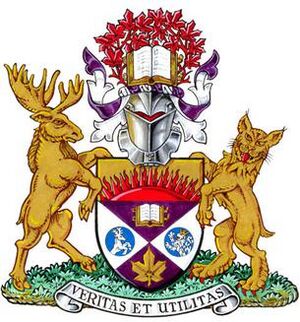 |
|
The university's coat of arms is a special symbol that represents Western. It was officially given to the university on January 15, 2014. It features an open book, a maple leaf, and a rising sun. The motto, Veritas et Utilitas, means 'Truth and usefulness' in Latin.
See also
 In Spanish: Universidad de Ontario Occidental para niños
In Spanish: Universidad de Ontario Occidental para niños
- 15025 Uwontario
- Western Mustang Band



